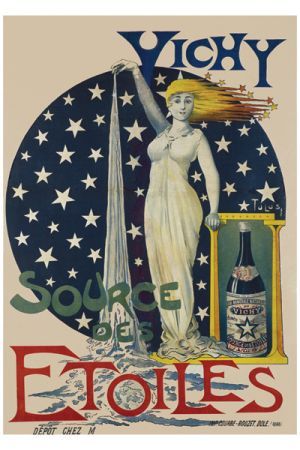Carbonated water is water in which carbon dioxide gas has been dissolved, thus creating tiny bubbles. It's what gives soft drinks their almost irresistible effervescence, but its allure is thousands of years old. Julius Caesar, for instance, had a spa built around the naturally carbonated springs of Vichy, in France, and to this day, balneologists (not your run-of-the-mill therapeutic specialists) recommend drinking Vichy water, notable for its sodium bicarbonate content, as a digestif.
Artificially carbonated water was invented by chemist Joseph Priestley (1733 - 1804), who published his findings in a 1772 paper titled "Directions for Impregnating Water with Fixed Air." He's most famously known, by the way, as the scientist who identified the gas oxygen, and as luck would have it, this coming Sunday is Oxygen Day at the Joseph Priestley House, in Northumberland, Pennsylvania. I can only wonder what Priestley, one of the world's great free-thinkers, would make of the current nonsense about the alleged harmful effects of carbonated water.
The rumors about sparkling water being bad for you likely stem from misheard, misunderstood, and/or poorly reported findings from studies such as one published in the Journal of Adolescent Health in May 1994. It found an association between cola consumption and bone fractures in 14-year-old girls, but no association between non-cola soft drinks and bone fractures was found.
Among subsequent studies that correlated soft-drink consumption (in particular, colas) with the risk of lower bone mineral density (BMD) was the much larger Framingham Osteoporosis Study, which showed that women (but not men) who drink more than three colas a week have a greater risk of low BMD (no matter how old they are or what their calcium intake is) than women who don't drink cola.
"Regular intake of cola, but not of noncola carbonated beverages [italics mine], may contribute to lower BMD in women," the researchers conclude. "No evidence exists that occasional use of carbonated beverages, including cola, is detrimental to bone."Carbonation and dental health
Carbonation results in the formation of carbonic acid, which gives plain carbonated water its distinctive flavor, but neither carbonation nor carbonic acid seem to have a significant effect on tooth enamel erosion. According to a 2001 study published in the Journal of Oral Rehabilitation, "sparkling mineral waters showed slightly greater dissolution than still waters, but levels remained low and were of the order of one hundred times less than the comparator soft drinks." If you're swilling multiple sugary, acidic colas every day, you're going to have eroded tooth enamel, cavities, and a whopping dentist's bill, but don't fault the carbonation in sparkling water, it's not bad for you.
Carbonation and cellulite
Cellulite is what happens when fat cells push against the connective tissue beneath your skin. Your age, genetic make-up, and thickness of your skin all factor into whether you will develop cellulite and, if so, how much you have. If you're still thinking sparkling water is bad for you, it's not, and it doesn't result in cellulite. What will contribute to cellulite is the inevitable weight you'll put on if you drink too many sugary sodas.
Is sparkling water bad for you? The takeaway
Carbonated water has no calories, no dissolved sugar, no alcohol, and no caffeine. It hydrates, just like plain water does. Drinking seltzer, club soda, or sparkling mineral water will not leach calcium from your bones, strip the enamel off your teeth, or make your thighs look like cottage cheese. Unless you have a medical condition that specifically precludes drinking carbonated beverages, enjoy it if so inclined. And if the thought of buying yet more stuff in plastic bottles or metal cans makes you nuts, think about getting one of those home carbonation gizmos like the SodaStream. If I had the counter space, I'd buy one in a New York minute. (And no, I'm not on the company's payroll.)
One last thing: Several people have asked me about Kangen and other ionized waters. That's a topic for another day, so watch this space.
Sparkling Water Glossary
Seltzer is the American version (circa 1810) of the naturally carbonated mineral water called Selters, from Germany. By the late 19th century, most American bottlers stopped including minerals and simply added carbonation to filtered tap water, which is what you get today. Particularly around New York City, seltzer is often referred to as "soda water." Fun fact: According to The Oxford Companion to American Food and Drink, seltzer used to be called Belchwasser in German or greps-wasser in Yiddish because of the way it aids digestion.
Club soda is also regular water to which carbon dioxide has been added, but it also contains added minerals such as potassium bicarbonate or potassium sulfate (they add a slight minerally flavor) and sodium. Club soda and seltzer can be used interchangeably in drinks.
Mineral waters come from underground springs and contain naturally occurring minerals. Unlike a still, or flat, mineral water like Evian, sparkling mineral waters such as San Pellegrino and Perrier come from naturally carbonated springs.
Tonic water is carbonated water that contains quinine, which comes from the bark of the South American cinchona tree (aka "fever tree") and was the first effective protection against malaria. Present-day tonic waters contain less quinine and their bitterness is balanced with sugar or (sigh) high-fructose corn syrup as well as proprietary botanical blends that may include citrus zests, lemongrass, and/or spices. What I would give for a gin-and-tonic right about now.




The only reason I will not use a SodaStream is that it is made in Israel.